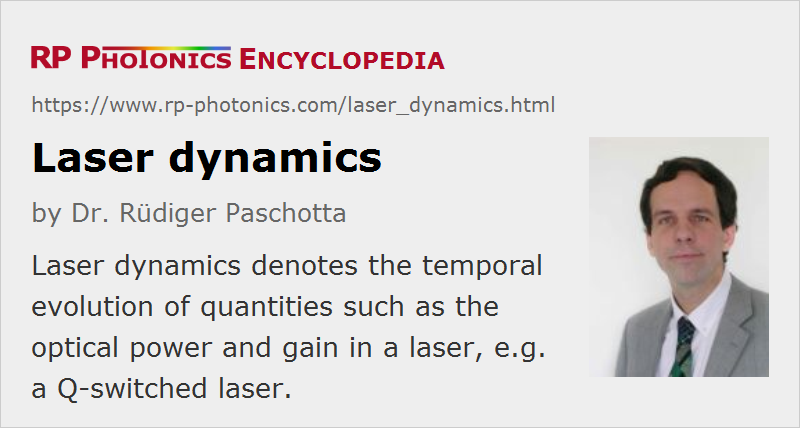Laser Dynamics
Definition: the temporal evolution of quantities such as the optical power and gain in a laser
German: Laserdynamik
How to cite the article; suggest additional literature
Author: Dr. Rüdiger Paschotta
The dynamic behavior of a laser is determined by the interaction of the intracavity light field with the gain medium. Essentially, the intracavity laser power can grow or decay exponentially according to the difference between gain and resonator losses, whereas the rate of change in the gain is determined by stimulated and spontaneous emission (and possibly by other effects such as quenching and energy transfer).
With certain approximations, including a not too high laser gain, the dynamics of the intracavity optical power P and the gain coefficient g in a continuous-wave laser can be described with the following coupled differential equations:
where TR is the cavity round-trip time, l the cavity loss, gss the small-signal gain (for a given pump intensity), τg the gain relaxation time (often close to the upper-state lifetime), and Esat the saturation energy of the gain medium.
Dynamic aspects of special interest in the case of a continuous-wave laser are the switch-on behavior (often including spiking of the output power) and its reaction to disturbances during operation (usually leading to relaxation oscillations). In these respects, different types of lasers exhibit a very different behavior. For example, doped-insulator lasers exhibit a strong tendency for spiking and relaxation oscillations, whereas for laser diodes this is not the case. Dynamic aspects are particularly important in Q-switched lasers, where the energy stored in the gain medium undergoes a large change during pulse emission. Q-switched fiber lasers, typically having a high laser gain, can exhibit additional dynamical phenomena. This can lead to a temporal sub-structure of the pulses, which cannot be explained with equations such as those given above.
Similar equations can be used for passively mode-locked lasers [1]; an additional term appears in the first equation, which describes the losses of the saturable absorber. The effect of this is typically that the damping of the relaxation oscillations is reduced. The relaxation oscillations may even become undamped, so that the steady-state solution becomes unstable, and the laser exhibits Q-switched mode locking or other kinds of Q-switching instabilities.
Questions and Comments from Users
Here you can submit questions and comments. As far as they get accepted by the author, they will appear above this paragraph together with the author’s answer. The author will decide on acceptance based on certain criteria. Essentially, the issue must be of sufficiently broad interest.
Please do not enter personal data here; we would otherwise delete it soon. (See also our privacy declaration.) If you wish to receive personal feedback or consultancy from the author, please contact him e.g. via e-mail.
By submitting the information, you give your consent to the potential publication of your inputs on our website according to our rules. (If you later retract your consent, we will delete those inputs.) As your inputs are first reviewed by the author, they may be published with some delay.
Bibliography
| [1] | A. Schlatter et al., “Pulse-energy dynamics of passively mode-locked solid-state lasers above the Q-switching threshold”, J. Opt. Soc. Am. B 21 (8), 1469 (2004), doi:10.1364/JOSAB.21.001469 |
| [2] | O. Svelto, Principles of Lasers, Plenum Press, New York (1998) |
| [3] | A. E. Siegman, Lasers, University Science Books, Mill Valley, CA (1986) |
See also: spiking, relaxation oscillations, pulse generation, double pulses, Q switching, lasers, gain saturation
and other articles in the category lasers
 |




If you like this page, please share the link with your friends and colleagues, e.g. via social media:
These sharing buttons are implemented in a privacy-friendly way!